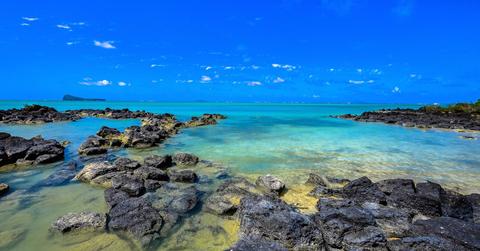Coral Reefs In Central America Are Finally Getting Healthier
The four countries boarded by the Mesoamerican Reef have banded together to protect this important marine life ecosystem, boosting their own economy in the process.
Updated Nov. 19 2020, 9:41 p.m. ET
Coral reefs have been struggling in recent years, with reports that huge swathes of it had succumbed to coral bleaching; the Great Barrier Reef had its most devastating die-off ever recorded in 2016, as CNN reported at the time. Bleaching happens when ocean temperatures get to hot.
As Stephanie Wear, The Nature Conservancy’s director of coral reef conservation, told Nature, the color from coral actually comes from tiny algae that live symbiotically with it.
“The first thing to understand is that corals get their brilliant colors from tiny algae that live in their tissues. These tiny organisms live in harmony with coral animals, and they basically share resources,” Wear explains. “For example, the most important thing that the algae do is provide food to the corals through carbohydrates they produce during photosynthesis."
Wear continued, “The next thing to understand is that corals have a limited temperature range within which they can live. When it gets too hot, they get stressed out—and this relationship with the algae goes sour. The tiny algae are ejected from the corals, turning them white, thus the term ‘bleached.’”
Coral and its supportive algae can repair itself if given enough time, but in recent years that's been impossible—and every year seems to get hotter. Coral only makes up one percent of Earth's undersea ecosystems, but they house about 25 percent of all marine life. They're like the metropolitan areas of the ocean.
This seems like something completely out of our control, but it is an issue everyone should be attuned with. The Healthy Reefs for Healthy People Initiative was formed by private companies, conservationists, and government agencies to give regular report cards on the health of coral reefs around the world, to keep people's interest and hope alive. They have some good news.
Mongabay reports that the Mesoamerican Reef, which spans Mexico, Guatemala, Belize, and Honduras and is second in size only to the Great Barrier Reef in Australia, is doing better. In 2006, the Mesoamerican Reef's health was designated as "poor." Now it is "fair." Okay, fair enough.
There is coral bleaching in the reef. About one fifth of it has gone white. But scientists say there was no coral death in 2015 or 2016. There has also been a surge in parrotfish and surgeonfish populations, which is important to the local economy as well as the ecosystem.
Larry Epstein, who works for the Environmental Defense Fund and HRI, said in a statement that the countries around the reef have banded together, recognizing the importance of the reef's health to their own wellbeing.
“Communities in Mexico, Belize, Guatemala and Honduras depend on the abundance and biodiversity of Mesoamerican Reef fisheries for jobs, food security and economic development,” he said.
One less positive piece of news is that there has been growth of “fleshy macroalgae" since 2006, now covering 23 percent of the reef versus 12 percent. But protecting algae-munching fish and improving sanitation and farm runoff could course-correct the issue. The message that improving coral reef health is a possibility is what people will be taking to the drawing board before HRI's next report card.
